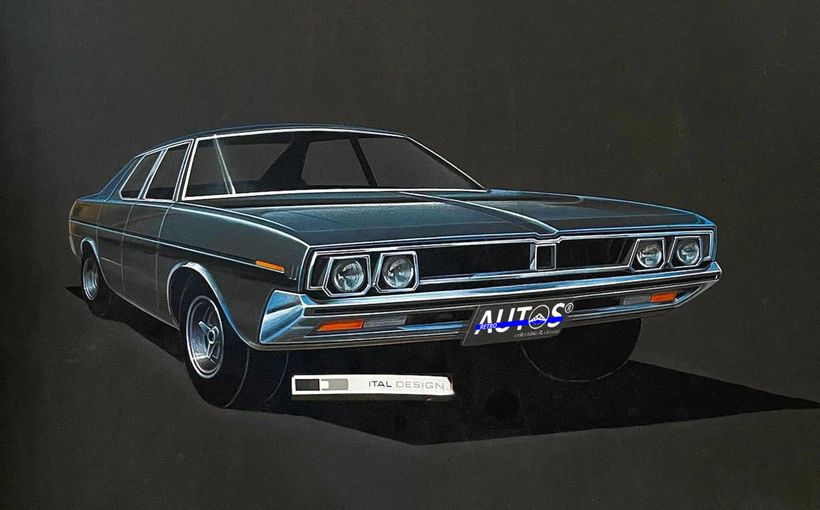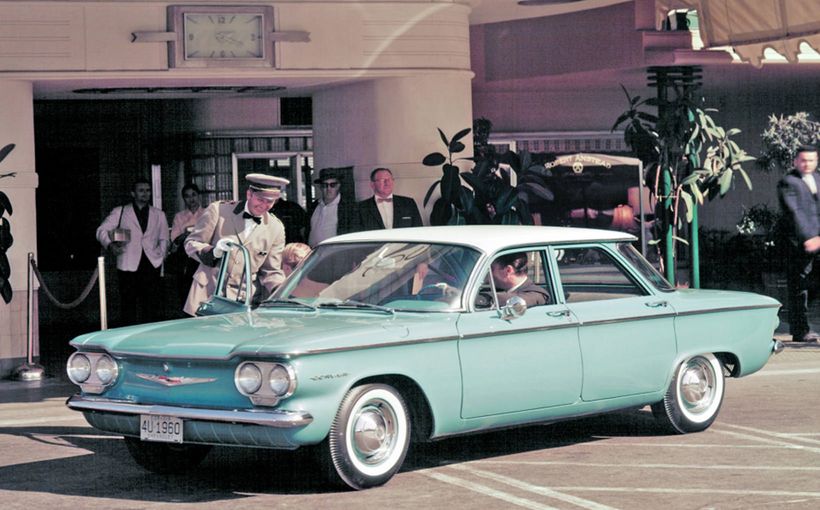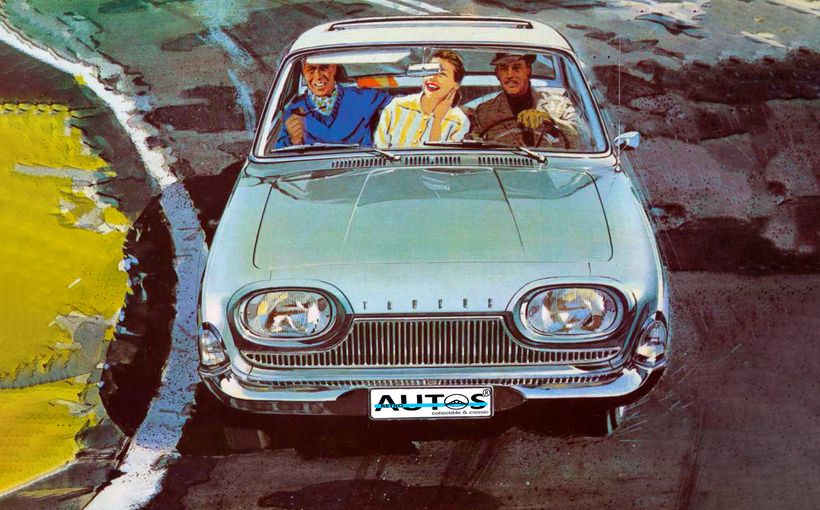
For many years the 1958 Chevrolet was overshadowed by its iconic 1955-57 predecessors and its outlandishly styled ’59 successor.
Its fate as a less regarded one-year wonder was sealed in July 1956 when a couple of GM’s designers gained a sneak peek of the ’57 Chrysler range.

What they saw shocked them. Called the Forward Look and designed by Virgil Exner, Chrysler’s thin roof lines, low heights, towering fins, lots of glass and a decided absence of chrome were way ahead of what GM were planning. As the legendary Plymouth advertisement proclaimed:
“Suddenly, it’s 1960!”
GM’s design department reacted by hitting the panic button. And they hit it again when the racy looking 1957 Fords appeared.

The younger designers immediately realised that GM’s reputation as a styling leader had evaporated. The company would face a serious commercial and competitive disadvantage if it persisted with the themes planned for 1958, and beyond, by its design czar, Harley Earl. This especially applied to GM’s biggest money earner, Chevrolet.

In their book, A Century of Automotive Style authors Michael Lamm and David Holls (GM’s retired design director) said that Earl loved cars that looked rotund and doughy. He liked high rounded roof lines, high bonnets, fins, chrome, chrome, chrome and more chrome. These themes were the opposite of Exner’s lithe 57 Chryslers. GM had to do something.

Trouble was, nothing could be done about the 1957 Chevrolet. It was already on its way to dealerships. Fingers were crossed that its three-year-old shape would attract buyers. The 1958 Chevrolet could not be changed either. By August 1956 its overall styling had been locked in. That left 1959 as the first opportunity to regain design leadership.


So, while Earl was away in Europe visiting cars shows and enjoying a vacation, the design teams openly ignored his dictates. Led by Bill Mitchell, they eagerly threw away the bloated facelifts of the ‘58 that Earl wanted for 1959 and started work on a completely new styling direction.

When Earl returned the new designs were well advanced. He was 12 months away from retirement, and with all of GM’s senior executives supporting the new direction, including GM Chairman Harlow Curtis, he could do nothing other than agree. The ’58 was the last Chevrolet for which Earl’s word on styling was the final word.

The directional change was validated at the end of 1957 when Ford beat Chevrolet in the annual sales race, 1.7 million to 1.5 million. Chevy’s market share sank from 29% to 25%. Chrysler’s overall sales jumped. Plymouth went up by 44%.
With another 12 months before the ‘59s appeared, all Chevrolet’s general manager, Ed Cole, could do was smile and say at the launch of the ‘58s was:
“I am confident that public acceptance of our outstanding new 1958 line will allow us to enlarge our share of the automotive market.”

You can get the inside information about the development of the 1959 Chevrolet and see all the crazy design ideas that were considered in the June 2018 edition of Retroautos®. There’s a link at the end of this story.
From Design to Driveway
We know when work started on the ’58 range—June 1955—because former GM designers Stan Mott and Bob Cumberford wrote about its design to driveway journey in the December 1957 edition of Motor Trend.

When the story appeared, both Mott and Cumberford had departed GM, so they were free to divulge what went on during the car’s development. The duo supported their month-by-month description with sketches and press photos.


One of the initial proposals was to carry over the roof from 1956-57 Chevrolet four door hardtop and apply it across the range. In fact, this roof shape dated back to 1954 when it was used on Buick and Oldsmobile coupes.

This idea was abandoned in favour of the reverse angle pillar. To save money, the two and four door sedans and hardtops shared the same windscreen, pillars and roof.


“Sculpturamic” was the descriptor that Chevrolet’s PR folk gave the Chevrolet’s design theme. The publicity proclaimed the car featured many “firsts.”
It was the first Chevrolet to have the new X-frame chassis. The first with all coil suspension and optional air bag suspension. It sat on a new 117.5-inch wheelbase, the longest since 1919. Dual headlights were another first as was the optional 348 cubic-inch V8.
And then there was the top of the range Impala. Its name, taken from the 1956 Corvette Impala Motorama dream car, would become synonymous with Chevrolet for five decades.

The product planning proposal for the Impala coupe and convertible had its genesis in an “executive” coupe that had been considered for 1955. It was positioned as an exclusive and aspirational, yet affordable, four-seater sports/luxury coupe.

To ensure the Impala had impact, it was given exclusive sheet metal from the firewall back. Chevrolet design studio manager, Clare MacKichan, summed it up for Special Interest Autos magazine in August 1980.
“It was decided to do it in order to achieve a specific look…so it would really stand out in a crowd.”

And stand out it did, featuring a lower and shorter roof and a lower windscreen. The rear pillar met the body further forward than the regular hardtop and sedan. The rear end was longer (because of the shorter roof) with wider and deeper creases encasing triple tail lights. The latter would become an Impala trademark. An air vent was added to the roof for a sporty appearance, but as MacKichan explains:
“They discovered that it actually let air in (so)… it was made a dummy.”


Success?

Describing the ‘58s as a success depends on what criteria you use. Chevrolet shifted 1.2 million of them, a massive 300,000 reduction on 1957. But, 1958 was a recession year in the USA. All car makers suffered from reduced sales. Even on its lower sales, Chevrolet lifted its market share to 29%. On the other hand, most of that lift was due to the Impala’s 188,000 sales. So, without the Impala, Chevrolet would have been almost line ball with Ford yet again. An upside was that the Impala outsold the Thunderbird by five to one.

Not impressed

Lamm and Holls were not impressed with the ’58 Chevrolet, nor any of GM’s offerings that year.: They observed that these cars reflected Earl’s inability to go beyond the forms he loved:
“With GM’s 1957 models (he) seemed to be groping, and by 1958 he’d lost his way.”

According to Lamm and Holls, Earl was not able to appreciate the quickly moving transition of car styling to sharp creases, angular shapes, large glass areas and delicate roof lines. Summing up they observed:
“Lots of designers get stuck in an era, and at this point (1957-58) Earl was one of them.”


Looking closely at the ’58 you can appreciate what Lamm and Holls are saying. The deeply sculptured sheet metal and abundant chrome try to hide Earl’s recycling of his previous design themes.
The reverse angle rear pillar was nothing new. It had been used by GM as far back as 1953. Most other car companies had employed it too. The kick up along the belt line at the rear doors was version of what had been seen on the tri-five Chevrolets. The wrapped front windscreen was a five-year-old design theme. The wrapped rear windscreen also had been seen before, on almost everything.

In the June 1994 edition of Collectible Automobile, writer Tom Murray said that the ’58 Chevrolets were:
“…a kind of bulbous boat that looks like it was sired by a Cadillac.”
No wonder the bulky ‘58s were overlooked as time went by. They represented the past, not the future.

Resurrection

As with so many overlooked, forgotten and ridiculed cars, there comes the moment of resurrection and the bestowing of respectability. For the 1958 Chevrolet, that moment was George Lucas’s 1973 semi-autobiographical movie American Graffiti.
Of the many cool cars that Lucas paraded in front of the cameras, the most dominant was a slightly customised 1958 Chevrolet Impala coupe. It was the star car, occupying 20% of screen time.
But don’t take my word for it. Let’s hear from famed NASCAR crew chief and team owner Ray Evernham. For many years he had known of the car’s existence and had approached the owner numerous times. In 2015 a price was negotiated.

Evernham told Car and Driver magazine and the Hard-Core Chevy website in November 2016 that he had been captivate by the ’58 Impala ever since he first saw the movie as a teenager
“When I was growing up, it was about that car…this car represented everything that was cool about America’s car culture.”
To me, that sure sounds like the resurrection and bestowing of respectability on Harley Earl’s last Chevrolet.

More about the 1959 Chevrolet
Special thanks to John Kyros at GM Heritage Centre. Retroautos® is written and published by David Burrell with passion and with pride. Retroautos® stories and images are copyrighted. Reproducing them in any format is prohibited. Retroautos® is a registered trademark. Reproducing it in any format is prohibited.








